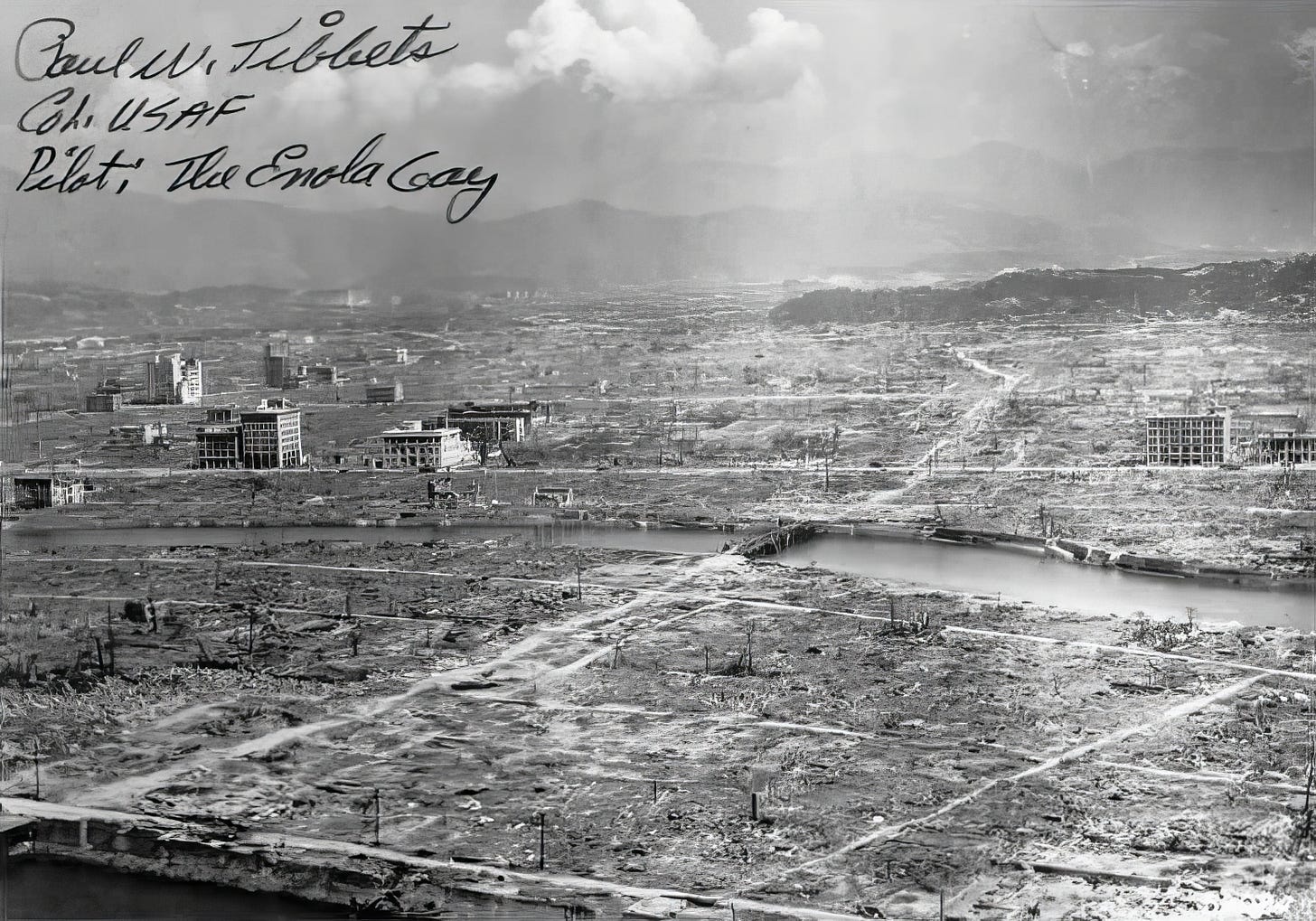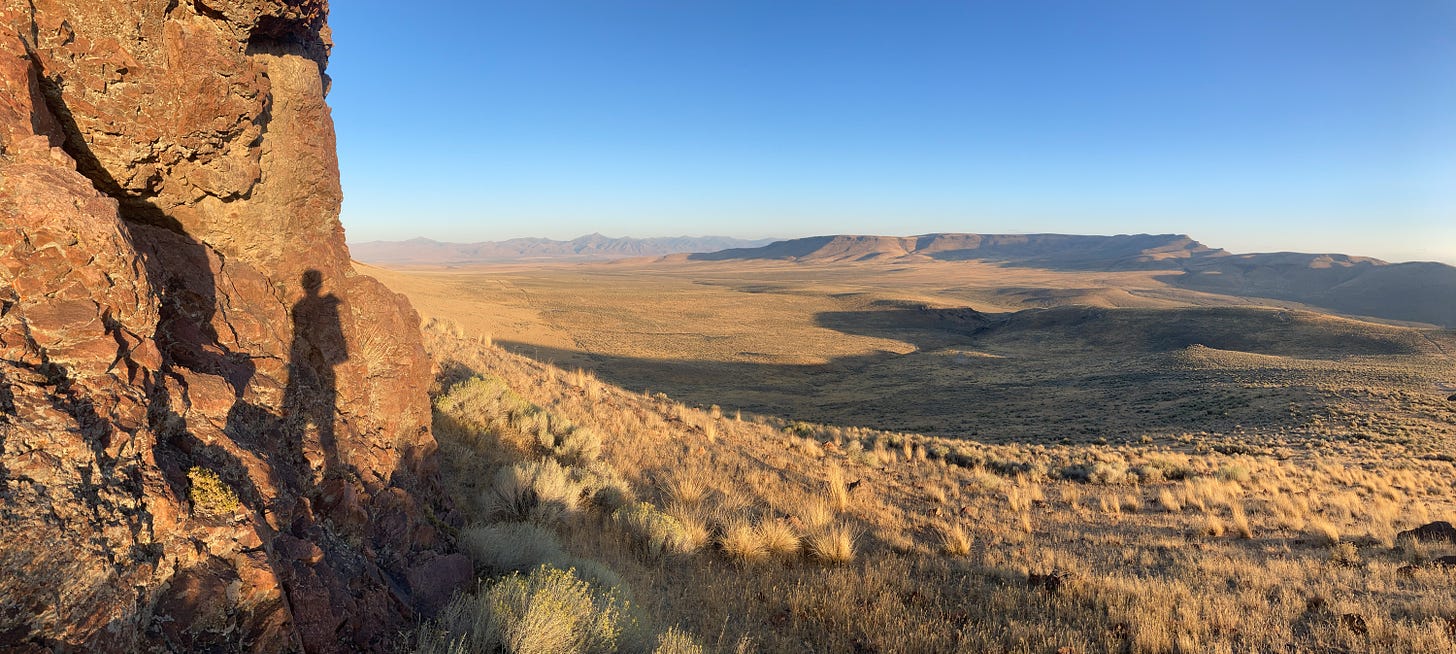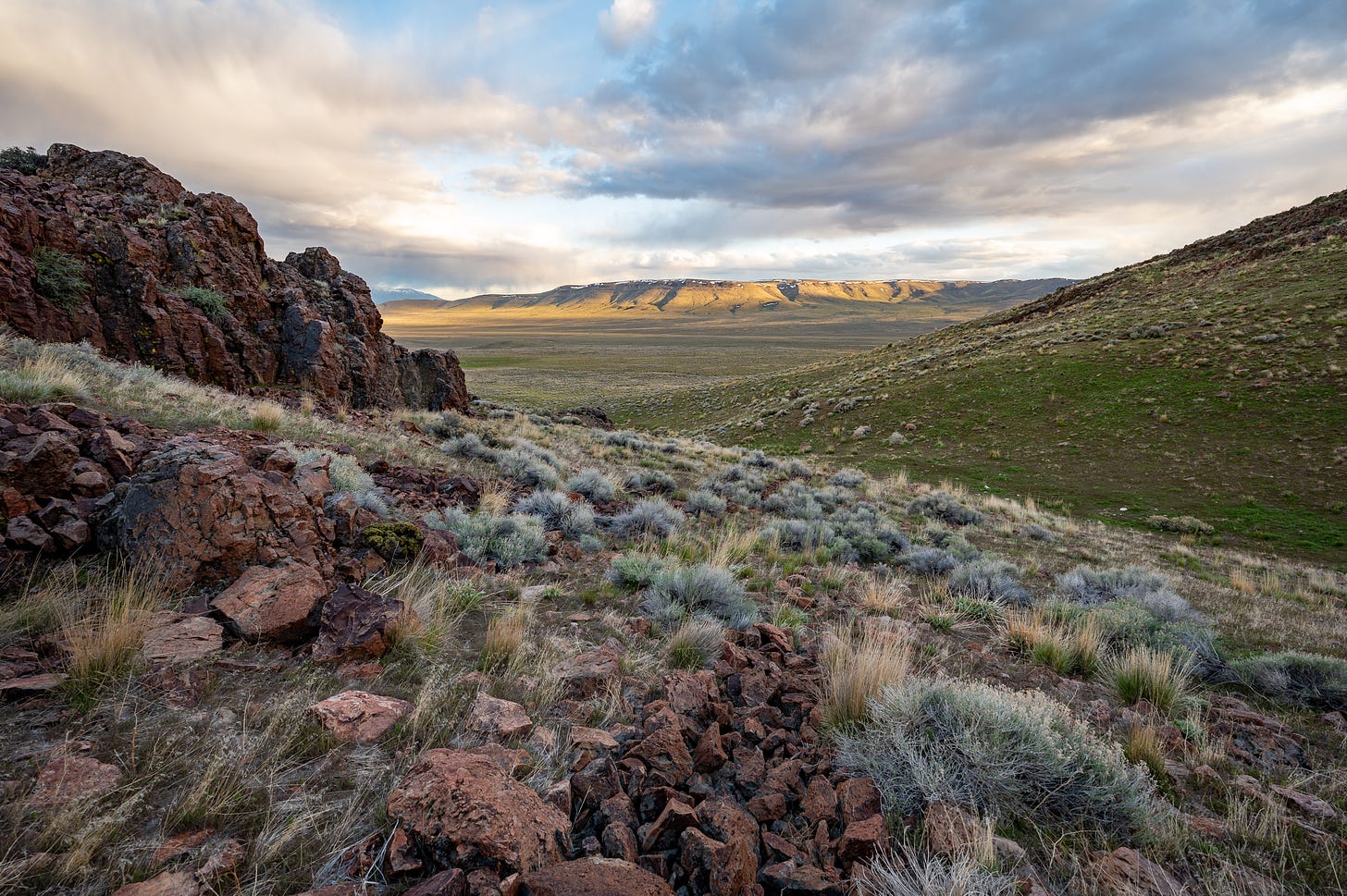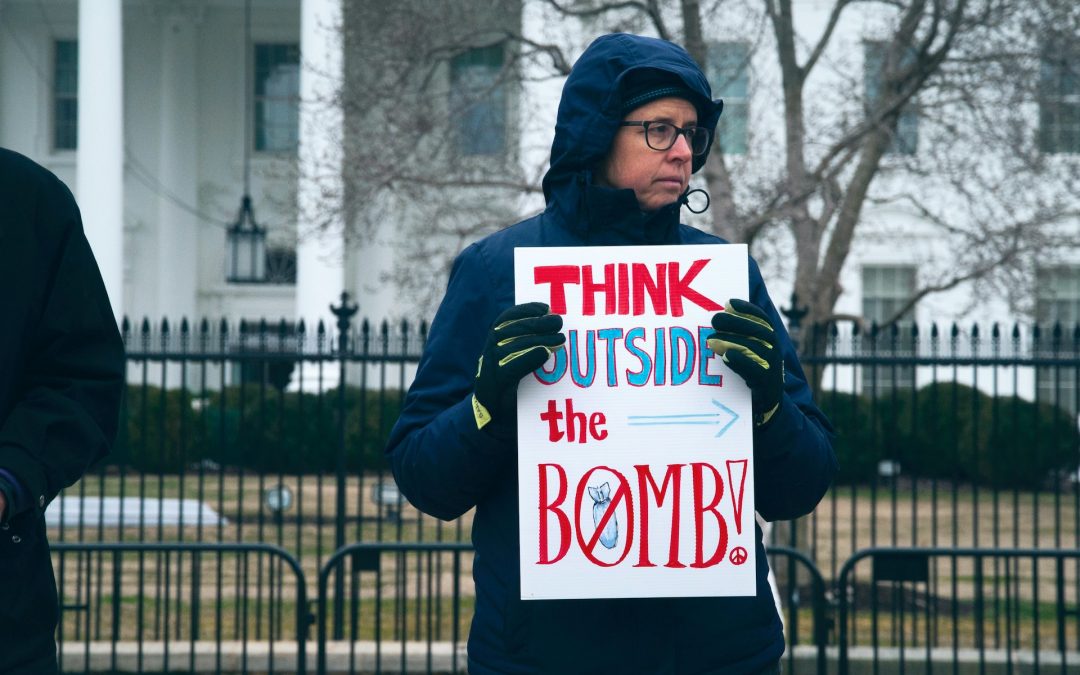Editor’s Note: This essay was originally published in 2021, but is timely today as the new Christopher Nolan film “Oppenheimer” has just been released. As people are coming to realize the Bright Green Lies of “renewable” energy, they are looking for other ways to continue their unsustainable lifestyles. Many people are seriously considering risking more nuclear reactor accidents, waste and nuclear winter as the war in Ukraine continues to escalate.
By Max Wilbert/Substack
“The unleashed power of the atom has changed everything except our thinking. Thus, we are drifting toward catastrophe beyond conception. We shall require a substantially new manner of thinking if mankind is to survive.”
― Albert Einstein
At 8:15am on August 6, 1945, cameras began to click on board the Necessary Evil, a military flight over southern Japan. Necessary Evil’s mission was to photograph the first atomic bombing in history. Nearby, on board another plane, the Enola Gay, bombardiers opened hatches on the belly of the plane and pulled levers to release the bomb.
It was called Little Boy. Ten feet long and 28 inches in diameter, it weighed 9,700 pounds, 141 of which were enriched uranium. The bomb dropped out of the plane and began falling. It took about 12 seconds to reach terminal velocity, which, for a big oblong object like Little Boy is around 1,000 feet per second. But the extra 12 seconds of time for spend accelerating meant that it took 53 seconds to fall from 31,060 feet to 1,900 feet, where it detonated.

The explosion began directly above a hospital, Shima byōin. Within a fraction of a second, the 80 residents and staff of that building, and perhaps 20,000 other people, were dead. The first died from thermal radiation, which travels at the speed of light and causes “flash burns.” Within seconds, the blast wave followed, traveling at 300 meters per second, rupturing eardrums, shredding lungs, tearing blood vessels, and flattening buildings.
Three days later, a second bomb was dropped on another city in southern Japan, Nagasaki. Within 4 months, as casualties from radiation burns and firestorms mounted, the death toll from these two bombs reached 200,000, with as many again injured.
Mass destruction was not new. Earlier that year, in March, 325 U.S. Air Force planes bombed Tokyo with napalm, igniting a firestorm that destroyed a quarter of the city and killed 100,000 people. But Hiroshima marked the beginning of the nuclear age. Now, the same destruction could be executed with a single plane and a single bomb.
Ever since, historians have argued over whether or not these bombings were necessary. The U.S. Military’s own review concluded “Based on a detailed investigation of all the facts… [that] prior to 31 December 1945, and in all probability prior to 1 November 1945, Japan would have surrendered even if the atomic bombs had not been dropped.” Many have concluded that the bombings were, as Nobel-prize winning scientist Patrick Blackett wrote, “the first major operation of the cold diplomatic war with Russia.”
That Cold War began with 200,000 deaths, and the atrocities would continue over the coming decades, all around the world: coups, assassinations, political purges, gulags, McCarthyism, proxy wars, and brutal economic combat.
While World War II and The Cold War have ended, the threat of nuclear war has not, and neither has the danger posed by nuclear power generation. And while the dangers of Three Mile Island, Fukushima, and especially Chernobyl [and the risks around Zaporizhzhya, today] cannot be underestimated, nuclear waste is perhaps a bigger danger than accidents.
This trifecta of horrors—nuclear war, nuclear accidents, and nuclear waste—still haunts our world today.
Immediately following the bombings of Hiroshima and Nagasaki, scientists from the Manhattan Project created a non-profit organization called the Bulletin of the Atomic Scientists dedicated to educating about the dangers our world faces “at a time when technology is outpacing our ability to control it.”
In 1947, members of the Bulletin launched “The Doomsday Clock” — a metaphorical representation of the likelihood of global catastrophe. Each year, a team of scientists, Nobel laureates, and others experts meets to consider the current state of man-made global threats from nuclear weapons, global warming, and disruptive technology, and set the time on the clock accordingly. The closer to midnight, the higher the level of danger.
The doomsday clock currently is set 90 seconds to midnight.
This is the direst warning the Bulletin has ever issued.
In explanation, the Bulletin’s scientists write that “Accelerating nuclear programs in multiple countries moved the world into less stable and manageable territory [over the past year]… Development of hypersonic glide vehicles, ballistic missile defenses, and weapons-delivery systems that can flexibly use conventional or nuclear warheads may raise the probability of miscalculation in times of tension… Nuclear nations… have ignored or undermined practical and available diplomatic and security tools for managing nuclear risks. By our estimation, the potential for the world to stumble into nuclear war—an ever-present danger over the last 75 years—increased in 2020. An extremely dangerous global failure to address existential threats… tightened its grip in the nuclear realm in the past year, increasing the likelihood of catastrophe.”
Last year, UN Secretary-General Antonio Guterres warned that the world has entered “a time of nuclear danger not seen since the height of the Cold War.”
The link between nuclear power and nuclear weapons is long established. The enriched uranium and plutonium, as well as other so-called “fissionable material” used in nuclear weapons, can be sourced from nuclear reactors, which is why Iran’s creation of a civilian nuclear power program has been so contentious over the past decade.
Proponents of nuclear power argue that it is a safe, low-carbon energy source. There are nearly 500 nuclear power reactors in the world today, with more under construction. But beyond the risks of nuclear accidents and the nightmare of nuclear waste (who thinks it is a good idea to intentionally unearth and enrich materials that will be highly toxic for billions of years?), each of these reactors is a potential vector for dangerous weapons-grade nuclear materials to be lost, stolen, or knowingly redirected into weapons programs.
According to the Nuclear Threat Initiative, there were 46 cases of nuclear materials being stolen between 2010 and 2016, as well as 57 cases of lost material, and dozens of other concerning incidents. There are already nearly 900,000 metric tons of weapons-grade uranium and plutonium stored around the world, most of it in Russia and the United States.

You may wonder how this is connected to Thacker Pass (Peehee Mu’huh” in the Paiute language). For the past 31 months, I have been working to protect this part of remote Northern Nevada from a proposed 28-square mile lithium mine. The mainstream environmental organizations weren’t doing anything about it, so I decided I had to.
Joining with my friend Will Falk and working to find other allies, we set out to stop the Thacker Pass lithium mine. Supporters of lithium mining believ it’s an essential mineral to help move away from fossil fuels and help, global warming. We disagree. Lithium is dangerous, for many reasons.
Climate change is, indeed, a serious threat to our planet. But that changing climate is a symptom of our consumeristic, earth-destroying culture—not the root of the problem. Electric vehicles won’t save the planet because a typical electric car requires six times the mineral inputs of a conventional car. The truth is, producing both electric and gas-powered cars is incredibly harmful to the planet. And lithium isn’t even possible to extract without massive quantities of fossil fuels. For example, oil from the “tar sands,” the world’s largest and most destructive industrial project, would be required for processing the lithium from the Thacker Pass mine.
Electric cars are not eco-conscious planet saving gadgets; they are luxury goods destined only for the wealthiest people on the planet.
I’ve explained in previous essays how this mine is actually about the money; how a greed so deep it is like lust underlies projects like this one. Similar feelings underlie community concerns about missing and murdered indigenous women and a rise in drug abuse that’s projected to accompany the mine. I’ve written in the past about the golden eagles who nest near Peehee Mu’huh, the meadowlarks, and the other wildlife who live in the pass and are threatened by this mine proposal.
In February 2021, we began to uncover the history of “Thacker Pass.” Over the spring, elders from the Fort McDermitt Tribe began to share with us the oral history of a massacre that gave the place it’s Paiute name, Peehee Mu’huh. And in August and September, evidence began to emerge documenting an 1865 massacre of Paiute men, women, children, and elders committed by the US Cavalry directly adjacent to the mine site. Two years ago, I challenged Lithium Americas CEO Alexi Zawadski’s characterization of his company as a good neighbor, asking if good neighbors usually dig up ancestors’ graves?

This work hasn’t been easy. We’ve endured winter storms, blistering temperatures, physical and legal threats, three years of long days and late-night work sessions, and the BLM is attempting to fine me and my friend Will Falk $49,890.13 for defending this land. Now, we’re being sued for defending the land. The forces arrayed against us are powerful. But we persist.
The booming demand for lithium is mainly driven by the electric vehicle industry, and demand for massive “grid-scale” batteries to store electricity from intermittent sources like wind and solar energy generation facilities. But lithium is also used in a wide variety of other industries.
This includes chemical propellants for rockets and torpedoes used by militaries and in spaceflight; in glass production; in metallurgy such as aluminum smelting, alloy production, and welding; in the production of fireworks and flares; and in the production of synthetic rubber and other plastics.
But here, I want to focus on a problem that I have not seen discussed before in regards to the Thacker Pass mine: the links between lithium and the nuclear industry.
There are two stable isotopes of lithium: lithium-6 and lithium-7. According to the World Nuclear Association, “Lithium-7 has two important uses in nuclear power today and tomorrow due to its relative transparency to neutrons. As hydroxide it is necessary in small quantities for safe operation in pressurised water reactor (PWR) cooling systems as a pH stabilizer, to reduce corrosion in the primary circuit. As a fluoride, it is also expected to come into much greater demand for molten salt reactors (MSRs).”
PWRs, or Pressurized Water Reactors, are a type of nuclear reactor that can be found in exactly two thirds of the world’s nuclear power plants. Engineers at these facilities, most of which are quite old at this point, are constantly dealing with corrosion in the components of their radioactive water cycling systems. Highly purified lithium-7 hydroxide is used in these systems “as an additive in PWR primary coolant, at about 2.2 ppm, for maintaining water chemistry, counteracting the corrosive effects of boric acid (used as neutron absorber) and minimizing corrosion in steam generators of PWRs.”
Lithium-7 is also used directly in nuclear weapons, where the reaction itself can produce the necessary tritium to fuel a runaway nuclear reaction. In 1954, the largest atmospheric nuclear weapons test in US history took place over the Bikini Atoll. Due to a shortage of lithium-6 (which is less common and hard to produce), the “Shot Bravo” nuke was built with lithium-7 instead. The bomb was projected to yield a 10-megaton blast. But due to lithium-7’s incredibly explosive features, the yield was 15 megatons—equivalent to every bomb dropped by the allies in World War II exploding at once.
One account describes the effect of the bomb: “An entire island turned into radioactive dust and the fallout seriously contaminated Bikini and two neighboring atolls. The ships of the Operation Castle task force steamed at flank speed away from the mushroom cloud, their decks covered with radioactive coral shards. The Japanese fishing vessel Fifth Lucky Dragon, sailing well outside the safety zone, suffered one death and several casualties from radiation. The bomb’s firing crew retreated to a closet in their concrete bunker for 12 hours while their Geiger counters roared.”
Lithium-6 is more rare than lithium-7 in nature, but is widely used in the nuclear weapons industry. When used as a target element in a reactor or a nuclear weapon, it reacts with a neutron to produce tritium (T), the most important thermonuclear material for weapons. According to the Institute for Science and International Security, “Lithium 6 is a critical raw material needed for the production of single-stage thermonuclear and boosted fission weapons.”
In the United States, the Tennessee Valley Authority operates three nuclear reactors. One of these, Watts Bar, uses lithium as the feedstock for producing tritium for use in nuclear weapons. This tritium is a key component in those weapons, but it needs to be constantly replenished. Tritium has a half-life of only 12.3 years and decays at 5.5% annually. That’s why tritium sourced from reactors using lithium is currently being used to rebuild and replace the U.S. nuclear arsenal as part of a 30-year, trillion dollar nuclear weapons plan launched under Obama.
Many critics of the nuclear weapons industry believe that nuclear power is, in general, little more than a civilian cover for the production of nuclear weapon material.
Meanwhile, advocates of nuclear power such as Bill Gates argue that next-generation reactors will address the problems that have plagued nuclear power—safety issues, radioactive waste, weapons proliferation, and high cost. But the Union of Concerned Scientists calls this “wishful thinking,” noting in their most recent report that serious concerns remain unresolved.
Modular Salt Reactors (MSRs), for example, produce massive amounts of radioactive waste that is exceptionally dangerous from a nuclear proliferation standpoint (U-233), and they are extremely difficult to clean up at the end of their relatively short lifespans. Current prototypes also depend heavily on lithium. Saudi Arabia and the United Arab Emirates are both on the verge of activating MSR reactors (perhaps with illegal assistance from the Trump Administration and U.S. corporations), which may lead directly to them becoming nuclear powers. And fusion reactors, for the foreseeable future, consume far more energy than they produce, amounting to nothing more than an exceptionally expensive and dangerous experiment (an experiment in which lithium is being used to control plasma).
The bottom line here is that the dangerous nuclear power industry, and the nuclear weapons that depend on it, require a steady supply of lithium. As nuclear tensions once again escalate, the Department of Energy is moving toward 100% U.S. sourcing of uranium in order to bypass international treaty obligations, which require the disclosure of locations and volumes of highly enriched uranium a country possesses. By cutting out foreign sourcing, the supply chain is kept more obscure. A similar consideration no doubt underlies, in part, the swift permitting of the Thacker Pass lithium mine. This mine is a part of the nuclear supply chain, and given that most U.S. lithium is now sourced overseas, war hawks no doubt prefer that this place is sacrificed.
One must step outside the halls of power to find sanity. The nuclear industry has been an unmitigated disaster from the beginning. I say this as someone who grew up in Washington State. We have seen the horror that is Hanford. And Nevadans know the perils of nuclear weapons and waste better than almost anyone else on the planet.
If the Thacker Pass lithium mine is built, lithium produced there may end up inside nuclear reactors and inside nuclear weapons. How would you feel if you were involved in a project that supplied critical material to power the next nuclear disaster?
Yes, Nevada has a bleak history of nuclear weapons testing and waste storage. Yet from the Nevada Test Site to Yucca Mountain, there is as long and as rich a history of resistance. Of sanity. Of desire for peace. I would like to invite all the activists, politicians, and regular people who fought nuclear testing and nuclear waste disposal across this region to join the fight against lithium mining as well.

There are many ways of laying waste to the Earth, and to our future. Nuclear technologies and strip mining are two of them. And in this case, they are firmly linked. That is why we must stand up against lithium mining and nuclear catastrophes alike.
“We all want progress, but if you’re on the wrong road, progress means doing an about-turn and walking back to the right road; in that case, the man who turns back soonest is the most progressive.”
― C. S. Lewis
The 2023 DGR conference is scheduled for late August in northern California. This annual gathering is an opportunity for our community to share skills, reflect on our work, strengthen our connections, and plan for the future. While this conference is only open to DGR members, we do invite friends and allies on a case-by-case basis. If you’re interested in attending, please contact us, and if you’d like to donate to support the conference, click here.
Photo by Maria Oswalt on Unsplash

